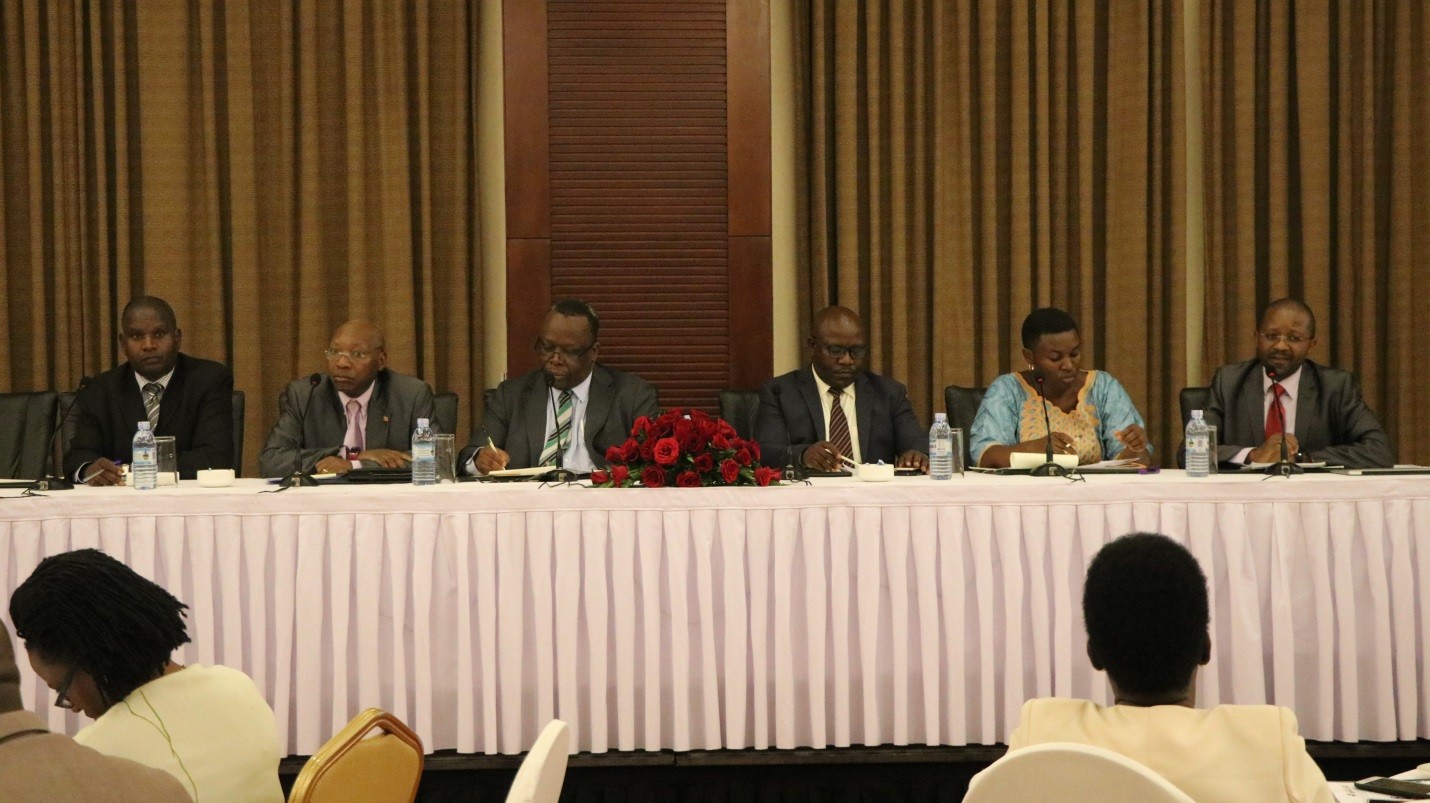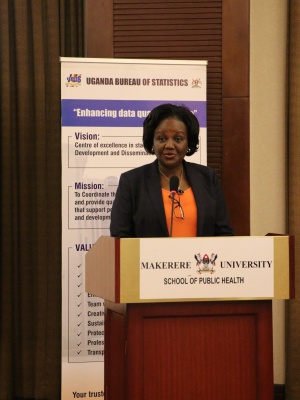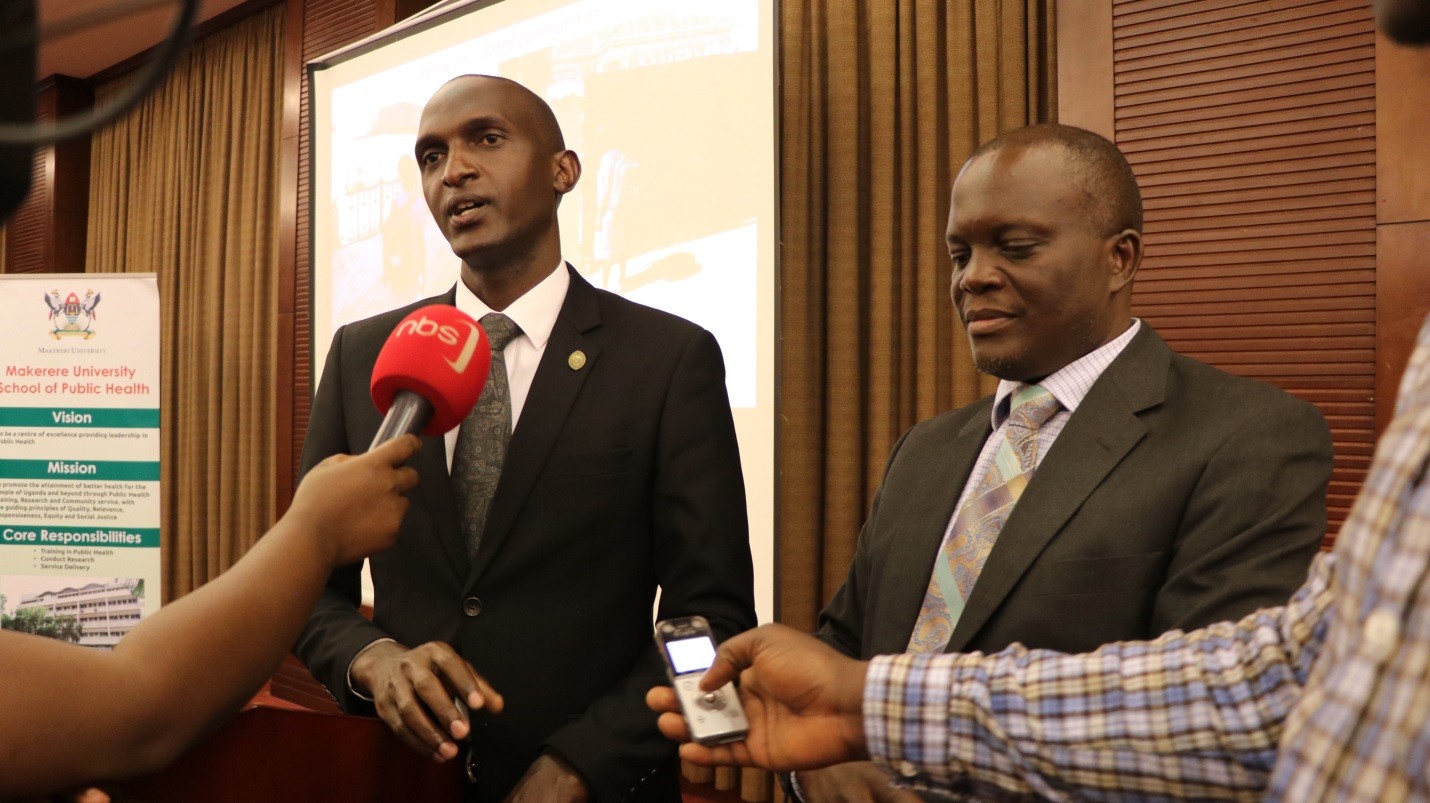
(L-R: Dr Placid Mihayo, representing Ministry of Health ;Dr Jotham Musinguzi-Director General, National Population Council; Prof Fred Wabwire-Mangeni-Senior Lecturer at MakSPH; Patrick Mugirwa, Program Officer at Partners in Population and Development-Africa Regional Office; Hon Justine Khainza, Woman MP, Bududa district; Dr Moses Muwonge, Executive Director-Samasha Medical Foundation)
Public Health (MakSPH),
Dr Rhoda Wanyenze
Uganda continues to make strides in the use of family planning methods and service delivery according to survey results disseminated by Performance Monitoring and Accountability 2020 (PMA2020) on July 24th 2018 at Kampala Serena Hotel.
However, despite these gains, the survey results point to the need for continued efforts to improve access to all family planning methods so that all women/ couples in Uganda can choose the best method for them from a range of choices.
In her opening remarks at the function, the Dean of Makerere University School of Public Health (MakSPH), Dr Rhoda Wanyenze, said, “We are very confident when we share these findings because we know that they represent what is happening in our communities.” She appreciated the various partnerships that have enabled the survey, and the audience of implementers and policy - makers, stressing that it is after implementation that research evidence has value.
She urged a continued working relationship with UBOS, citing the comparative advantage of UBOS and MakSPH as more reason to jointly explore what else the two institutions can do.
MakSPH at the College of Health Sciences (MakCHS) led this PMA2020 research in collaboration with the Uganda Bureau of Statistics (UBOS) and the Ministry of Health.
Sharing the findings, Dr Simon Peter Kibira, a lecturer at MakSPH and a co-investigator in this research revealed some very shocking figures. He pointed out that 46% of the women interviewed in the study reported unintended births for their last child; 15% reported that they no longer wanted children. This is an increase in “unwanted children” from last year when 40% and 13% reported unintended births and no longer wanted children respectively.
In addition, it was revealed that 26% of the women were complacent about making sure they did not have children they did not intend to have, and yet they were sexually active. This means that these women are leaving conception to chance. Also worrying was the finding that rural women show a seven – year gap between age of first sex and age of first use of contraceptives; urban women reported only a 3 and a-half – year gap. The data showed that rural women had 2 – 3 children by the time of first use of contraceptives; their urban counterparts had 1 child.
However, the long acting reversible and permanent methods especially implants are beginning to take root. And injectables were the most used method of contraception for married women. Many women are also opting for implants. Among sexually active unmarried women, the emergency pill is a growing contraception method.
The study also found that almost 50% of women are not counseled by health workers about the possible side effects of the family planning methods before enrollment. This probably explains why uptake in use in not growing as expected, because the main reason among non – users of contraceptives, was found to be fear of side – effects.
Dr Frederick Makumbi, a senior lecturer at MakSPH and the lead investigator in the PMA2020 study equally presented findings on the state of family planning stocks in the health centres where the study was conducted. He revealed that 36% of the 342 health centres visited were stocked out of injectables, which happen to be the most commonly used contraceptives while a third of the health facilities visited were stocked out on family planning pills. “There are many methods that are not available by policy at these health centres. But again, that’s where majority of the women have access”, he highlighted, further alluding to whether it was time to change the policy. “The fact of the matter is it does not matter whether a health centre should offer these services, to these men and women because that is where they have access. Is it a good thing, maybe it should be thought about because offering these services is a good thing”, suggested Dr Makumbi.
With this kind of findings, we might as well not be able to meet our family planning goals as a country for the year 2020.
Alain Sibenaler, the United Nations Population Fund (UNFPA) Uganda representative noted the persisting inequalities between the rural and urban population in reference to accessibility and acceptability of family planning methods, stressing the need to address these inequalities. “We need to move towards policy change at the different levels, to increase availability and affordability of different methods of family planning, and we are happy to support the Ministry of Health in doing that. It also means increased training in counseling. We must also look at girls at the age below of 15 when it comes to teenage pregnancies. He concluded with a call for leadership and coordination, especially in supply chain management, to ensure elimination of stock-outs at health centres.
Dr Placid Mihayo from the ministry of Health, while delivering the closing remarks, thanked MakSPH for the research done, promising more collaboration with MoH to inform policy. Urged partners to handle issues of re-distribution and quantification with government, for districts to know quantities within a specific time, to order for what they can use.
Commenting on the current stock – outs in the country, Dr Placid emphasized the need for partners to work with government in re-distribution and quantification of products. “We have to insist on returns and stock –at-hand before we can give you more products, to avoid shortage at national level yet some facilities are over-stocked”, he held, adding that alternative distribution was still being discussed. “Products procured by UNFPA through UHMG, we have to keep ordering them from UHMG till December this year. USAID and Global Fund 2 are already in Joint Medical Stores”, he explained.
Present at the function were members of the Parliamentary Health Committee led by its Chairperson, Hon Dr Michael Bukenya. The meeting was also graced by the Executive Director of Uganda Bureau of Statistics, Dr Ben Paul Mungyereza; Dr Jotham Musinguzi, the Director-General of National Population Council.
About PMA2020
Overall direction and support is provided by the Bill & Melinda Gates Institute for Population and Reproductive Health at the Johns Hopkins Bloomberg School of Public Health and funded by the Bill & Melinda Gates Foundation.
PMA2018/Uganda Round 6, the sixth round of data collection in Uganda conducted from April to May 2018, uses a two-stage cluster design with urban-rural and region as strata. The project used the same set of 110 enumeration areas (EAs) as those that were selected in the previous round and drawn by the Uganda Bureau of Statistics from its master sampling frame. In each EA, households and health facilities were listed and mapped, with 44 households randomly selected. Households were surveyed, and occupants enumerated. All eligible females age 15 to 49 were contacted and consented for interviews. The final sample (and completion rates) included 4,558 households (96.8%), 4,225 de facto females (96.8%) and 342 health facilities (94.7%).



